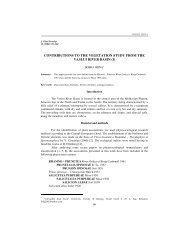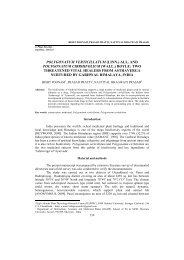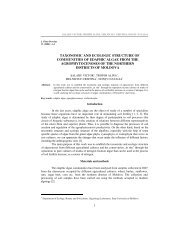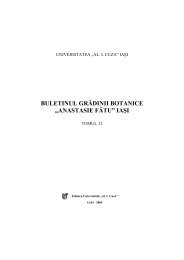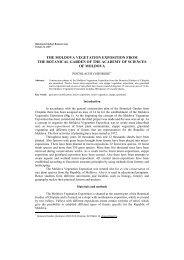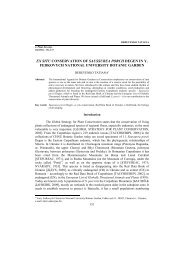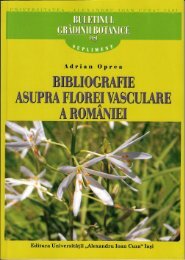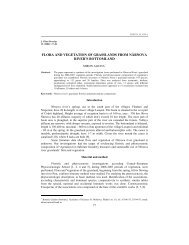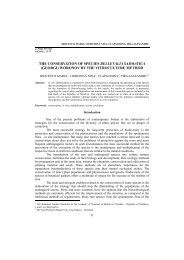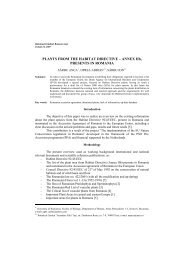importance of mushroom colections used for mycology knowledge
importance of mushroom colections used for mycology knowledge
importance of mushroom colections used for mycology knowledge
Create successful ePaper yourself
Turn your PDF publications into a flip-book with our unique Google optimized e-Paper software.
IMPORTANCE OF FUNGAL COLLECTIONS FOR MYCOLOGY IN THE FRAME OF …<br />
The dried macromycetes specimens kept carefully preserve their microscopic<br />
structure. This aspect makes them adequate <strong>for</strong> important mycologic collections or those<br />
<strong>used</strong> <strong>for</strong> their scientific and didactic purpose.<br />
For the specialists who collect fungi, especiually <strong>mushroom</strong>s, <strong>for</strong> a collection, they<br />
have to follow some instructions:<br />
– preservation has to be realized without affecting the specie continuity inside <strong>of</strong><br />
collecting area;<br />
– quality <strong>of</strong> preserved material – this material have to be collected in successive stages<br />
<strong>of</strong> development, including the stages with mature spores; it is recommended to collect<br />
only young and mature exemplars (cap, stalk, ring, volva, and gills), without free larva<br />
and snails. The <strong>mushroom</strong>s could be collected especially during spring, summer and<br />
autumn. Sporiferous bodies will be cleaned, throuing soil particles. It is recommended<br />
to be avoid an excessive manipulation because this material is very fragile (many<br />
elements <strong>used</strong> <strong>for</strong> identification could be destroyed).<br />
– quantity – it will be collected enough biologic material only where this is possible; the<br />
collecting have to be done into substrate <strong>for</strong> a minimum deterioration <strong>of</strong> their structure.<br />
– notes about collecting areas – have a major <strong>importance</strong> <strong>for</strong> species identifications; this<br />
in<strong>for</strong>mation have to mentioned specific characteristics <strong>of</strong> fungi/<strong>mushroom</strong>s, especially<br />
those one which are deteriorated through drying process (dimensions, <strong>for</strong>m, colour,<br />
texture, taste, smell etc.). The notes have to registered in<strong>for</strong>mation about collecting<br />
area, association mode <strong>of</strong> individuals. It is recommended that collecting to be realized<br />
together with substrate, especially <strong>for</strong> parasite species. Species <strong>of</strong> lignicolous<br />
<strong>mushroom</strong>s, which growing up usually on wood, will be collect with their substrate.<br />
The same recommendations are available <strong>for</strong> saxicolous lichens.<br />
– colour photos – will be done <strong>for</strong> all collected individuals, and these photos will be<br />
added to the „notes about collecting area” to completing in<strong>for</strong>mation about:<br />
fungus/<strong>mushroom</strong> characteristics, their distribution and ecology.<br />
– necessary equipment – is composed by a basket, paper bags or waxed paper bags <strong>used</strong><br />
<strong>for</strong> <strong>mushroom</strong>s wrapping, each <strong>of</strong> them in different bags, especially <strong>for</strong> individuals<br />
with large sporiferous bodies; also, the collecting will be done in metallic or plastic<br />
boxes <strong>for</strong> <strong>mushroom</strong>s with medium dimensions, and in tubes or small boxes <strong>for</strong> little<br />
<strong>mushroom</strong>s. There is no recommended the depositing <strong>of</strong> <strong>mushroom</strong>s in plastic bags.<br />
For separation <strong>of</strong> <strong>mushroom</strong>s away from their substrate we have to use knives,<br />
scissors, mallet, all <strong>of</strong> them adequate <strong>for</strong> this kind <strong>of</strong> actions.<br />
Chemical characters <strong>of</strong> pulpous <strong>mushroom</strong>s have a very important role in their<br />
macro- and microscopic determinations [TĂNASE, 2002; KIRK & colab., 2001/2004, p.<br />
120; ŞESAN & TĂNASE, 2004].<br />
The ferrous sulphate (FeSO 4 ) is <strong>used</strong> both as aqueous solution 10% and as<br />
crystals. The using <strong>of</strong> crystal depends on age and texture humidity (pulp, flesh) which are<br />
already tested. This is <strong>used</strong> <strong>for</strong> deterioration <strong>of</strong> some species from Russula and Boletus<br />
genera.<br />
Phenol (phenol acid in aqueous solution 2%) is <strong>used</strong> <strong>for</strong> identification <strong>of</strong> some<br />
species <strong>of</strong> the genera as: Russula, Amanita and Cortinarius. The positive reactions could be<br />
common with a brown colour, but there could be registered intense reactions which<br />
coloured in red or black the tissues <strong>of</strong> some fungi/<strong>mushroom</strong>s.<br />
The ammonia is <strong>used</strong> as aqueous solution. Reactions are coloured in red, yellow<br />
up to purple.<br />
110



